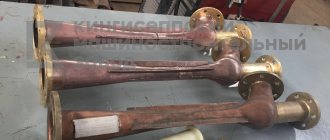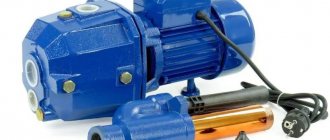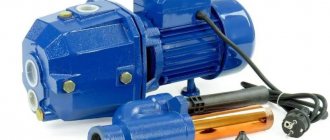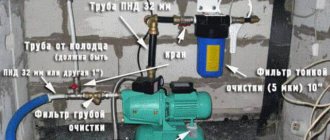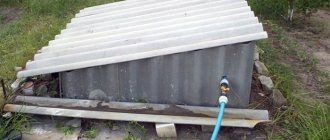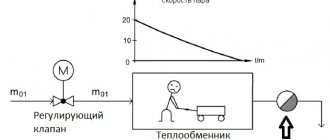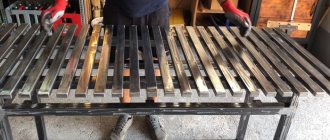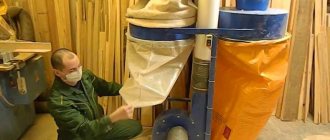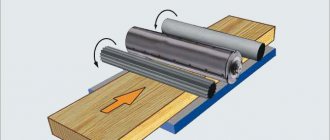Almost everyone who has been involved in arranging an autonomous water supply has encountered the problem of insufficient water supply to the suction pump. From the physics course we know that atmospheric pressure allows water to be supplied from a maximum depth of 9 meters. In practice, this figure decreases to 7 and even 5 m of confident delivery. An ejector for a pumping station will help solve the problem, allowing you to increase the water pressure. The industry produces such equipment, which is part of pumping stations and pumps.
Types of ejector pumps
An ejection pump is a useful thing on the farm, especially if there are deep wells on the site.
To make it convenient to use them, you need to choose the pumping equipment option that suits you. There are several types of ejector pumps, they are divided according to their operating principle and design:
- A steam ejector pump pumps out gaseous media from confined spaces. Thanks to this, a rarefied environment is maintained. Such ejectors are used quite often.
- A jet steam ejector sucks gases or water out of a confined space using the energy of steam jets. In this case, jets of steam exit the nozzle and force water to move, which exits the annular channel through the nozzle.
- A gas (or air) ejector compresses gases that are already in a rarefied environment using highly directed gases. This process occurs in a mixer, from which water flows into a diffuser, where it is slowed down and the voltage increases.
Ejector pumps have excellent performance properties
Ejectors also differ in their installation location:
- The built-in water ejector is installed inside or next to the pump. Thanks to this arrangement, the device takes up minimal space and is not afraid of dirt. In addition, such devices do not require the installation of additional filters. They are used for wells whose depth is no more than 10 meters. In addition, built-in ejectors make a lot of noise during operation and require a powerful pump.
- The device, which is called remote (or external), can be installed at a certain distance from the pump, but not more than 5 meters. They are often placed in the well itself.
All types of ejectors are suitable for use in a private home. They help to quickly pump water out of a well, despite its depth.
Conclusions and useful video on the topic
This video discusses in detail the issue of the suction depth of a surface pump and options for solving the problem using an ejector:
The principle of operation of the ejector is clearly demonstrated here:
An ejector is a simple but very useful device. This is a convenient and useful way to improve the performance of pumping equipment in a private home. But the installation of the ejector, especially the remote model, must be done correctly; this is the only way to ensure a noticeable increase in water pressure.
Choice of built-in or external
Depending on the installation location, there are remote and built-in ejectors. There is no big difference in the design features of these devices, but the location of the ejector still affects in some way both the installation of the pumping station and its operation.
So, built-in ejectors are usually placed inside the pump housing or in close proximity to it. As a result, the ejector takes up minimal space and does not have to be installed separately; it is enough to carry out the usual installation of the pumping station or the pump itself.
In addition, the ejector located in the housing is reliably protected from contamination. Vacuum and reverse water intake are carried out directly in the pump housing. There is no need to install additional filters to protect the ejector from clogging with sludge particles or sand.
However, it should be remembered that this model demonstrates maximum efficiency at shallow depths, up to 10 meters. Pumps with a built-in ejector are designed for such relatively shallow sources; their advantage is that they provide excellent incoming water pressure.
As a result, these characteristics are sufficient to use water not only for domestic needs, but also for irrigation or other economic operations. Another problem is the increased noise level, since the vibration of the operating pump is added to the sound effect of water passing through the ejector.
If you decide to install a pump with a built-in ejector, you will have to take special care of sound insulation. It is recommended to install pumps or pumping stations with a built-in ejector outside the house, for example, in a separate building or in a well caisson.
The electric motor for a pump with an ejector must be more powerful than for a similar model without an ejector.
An external or external ejector is installed at a certain distance from the pump, and this distance can be quite significant: 20-40 meters, some experts even consider 50 meters acceptable. Thus, a remote ejector can be placed directly in a water source, for example, in a well.
Of course, the noise from the operation of an ejector installed deep underground will no longer disturb the residents of the house. However, this type of device must be connected to the system using a recirculation pipe through which the water will return to the ejector.
The greater the installation depth of the device, the longer the pipe will have to be lowered into the well or well.
It is better to provide for the presence of another pipe in the well at the design stage of the device. Connecting a remote ejector also involves installing a separate storage tank from which water will be drawn for recirculation.
Such a tank allows you to reduce the load on the surface pump, saving some energy. It is worth noting that the operating efficiency of the external ejector is somewhat lower than that of models built into the pump, however, the ability to significantly increase the intake depth makes one come to terms with this drawback.
When using an external ejector, there is no need to place the pumping station directly near the water source. It can be installed in the basement of a residential building. The distance to the source can vary within 20-40 meters; this will not affect the performance of the pumping equipment.
Device installation features
As already mentioned, installing an ejector built into the pump does not cause any particular problems, since the device is already located in the device body. The surface pump is simply connected to the water supply hose on one side, and also to the water supply system on the other side.
If it is used as part of a pumping station, then the pump is connected to the hydraulic accumulator through a special fitting with five outputs. In addition, the pump will need to be connected to the contacts of the pressure switch to ensure that it turns on and off automatically.
This diagram clearly shows the procedure for connecting a remote ejector to a pumping station, indicating the installation locations of all necessary components
Before turning on the surface pump, it must be filled with water through the filling hole provided for this purpose. You cannot turn on such equipment without water, it may burn. If the pump is installed correctly, the ejector will operate without interruption.
But the installation of a remote ejector is carried out according to a more complex scheme. First, you will need to install a pipe that will ensure the return flow of water from the storage tank to the ejector. A check valve is installed on the suction section of the ejector. A mesh filter should be placed behind it to protect the device from clogging.
An adjustment valve must be installed on top of the recirculation pipe to regulate the amount of water that is directed to the ejector. This unit is not mandatory, but can significantly improve the situation with water pressure in the house. The less water is returned to the ejector, the more of it will be left for the home's plumbing system.
The ejector is assembled before operation according to the standard scheme. A mesh filter is connected to the ejector body from below, and a Venturi tube made in the form of a plastic socket (+) is connected to the top through the nozzle.
This way you can influence the water pressure in the water supply. If it is insufficient, you should slightly tighten the adjusting valve on the return line. If the pressure is too high and creates unnecessary stress on the plumbing system, it makes sense to direct more water to the ejector in order to increase the efficiency of the pumping equipment.
Some industrial models of ejectors are already equipped with such an adjustment system. The instructions that come with the device usually describe in detail how to configure the ejector.
Making an ejector with your own hands
To make the device yourself you will need the following parts:
- The tee will act as the basis for the device.
- The fitting will become a conductor of high pressure flow.
- Using couplings and bends, the ejector will be assembled and connected to the system.
The above parts for assembling the device with your own hands are assembled in a certain order:
- You need to take a tee with ends designed for threaded installation. The thread must be internal.
- You need to screw the fitting into the lower part of the tee with the outlet pipe facing up. You need to screw the base of the fitting into the tee, placing the outlet pipe inside the base of the device. In this case, the pipe should not stand out on the opposite side of the tee. If it is very long, then they resort to turning it.
- The short fitting is extended using a polymer tube. The interval from the end of the tee to the end of the fitting should be about 2-3 mm.
- An adapter is attached to the upper part of the tee located above the fitting. One end of it is designed with an external thread; it is attached to the base of the future device. The second side is equipped as a compression fitting for a metal-plastic pipe; water from the well will circulate through it outside the device.
- Another fitting needs to be installed in the lower part of the tee, where the fitting is already located. This will be a corner (bend), and the recirculation line pipe will be installed on it. Therefore, before installation, it is necessary to grind the lower threaded part of the fitting to 3-4 threads.
- A second angle is attached to the side branch, which ends with a collet clamp for installing a supply pipeline through which water flows from the well.
- Threaded connections are installed on a polymer seal. If instead of pipes there is molding made of polyethylene, then crimping elements are used as collet fittings for metal-plastic, which are designed for reverse shrinkage of polyethylene. Pipes made of cross-linked polyethylene can be bent in any direction, so you can save on corners.
After assembling the ejector, you need to connect it to the pumping station for your home. If the device is connected outside the well, then a pumping station with an internal device, but if the ejector is lowered into the shaft under water, then the equipment is with an external unit.
Then, in the latter case, three pipes will need to be connected to the assembled device:
- One of them will be attached to the side end of the tee. Its immersion will occur almost to the very bottom; its end must be equipped with a mesh filter in a glass housing. This pipe is needed to organize a flow with pressure.
- A second pipe should be connected to the lower end of the tee. It should be connected to the pressure line that comes out of the home pumping station. Thanks to this, a flow will be created in the ejector that will move at high speed.
- A third pipe is connected to the upper end. It must be brought to the surface by connecting to the suction pipe of the pump. Thanks to the ejector, an increased flow of pressure will flow through this pipe.
An ejector is an indispensable device for creating good water pressure, as well as for protecting supply equipment from running dry. You can buy it together with a pumping station or assemble it yourself. It will work effectively for a long time, ensuring an uninterrupted supply of water even from a deep source.
Using a homemade external option
A built-in ejector is usually purchased at the same time as a pump, but the external model is often made by hand. It will be useful to consider the creation process and the procedure for connecting such a device. In order to make an ejector, you will need such parts as a tee with internal threaded connections, fittings, fittings, bends, couplings, etc.
Personal assembly of the ejector
Assemble the device as follows:
- Connect the lower part of the tee to the fitting so that the outlet pipe is at the top, and the fitting with a smaller diameter is inside the ejector.
- Then you need to modify the design by cutting off the narrow part of the fitting if it protrudes from the tee.
- If the fitting is too short, it is extended using a polymer tube.
- An adapter with an external thread is screwed onto the top side of the tee.
- A PVC water pipe is connected to the other end of the adapter using a fitting.
- Now, a bend in the form of an angle should be attached to the lower side of the tee, into which a narrow fitting is already inserted.
- A pipe is connected to this outlet, through which the reverse flow of water will flow to the ejector.
- Another corner is attached to the side pipe of the tee.
- A pipe is attached to this corner using a collet clamp; water will be sucked through it from a well, well, etc.
The distance between the edge of the tee and the fitting should be approximately 2-3 mm. This will ensure the creation of a vacuum region with the necessary characteristics. To secure the recirculation pipe, use a crimp nut.
It turns out that two elements are simultaneously attached to the internal thread of the lower branch pipe of the tee. One of them (fitting) is located inside the tee, and the second (angle) is outside. In order for both of them to fit on one threaded connection, part of the thread of the fitting should be cut off.
Of course, all threaded connections must be sealed and sealed. Most often, FUM tape is used for this. Sometimes, to connect the ejector to the pumping station, not metal-plastic pipes are used, but polyethylene structures. To install them, you should use special crimping elements, and collet clamps, which are good for metal-plastic, are not suitable in this situation.
All threaded connections of the ejector should be carefully sealed and sealed, for example, using FUM tape or other suitable material
Pipe connection procedure
You should think in advance about which pipes the remote ejector will be connected to. Polyethylene structures bend well when heated, which makes it possible to do without corners when connecting the ejector. The pipe is simply bent in a suitable place and at the desired angle, and then attached to the ejector.
To connect the ejector, you can use polyethylene pipes, which are easier to install than similar structures made of metal-plastic
So, the device has three outputs, to each of which a corresponding pipe should be connected. First, a pipe is usually installed through which water will be drawn from the source. It connects to the side outlet of the ejector.
A check valve must be installed at the end of this pipe, as well as a strainer. This pipe must be long enough to reach deep into the water. But you should not take water from the very bottom of the source, as this can lead to clogging of the ejector, even despite the presence of a filter.
You can then attach the pipe to the lower end of the ejector, which has a tapered fitting. This is the pipeline through which water is recycled. The second end of this pipe should be connected to a container from which water will be drawn to create a return flow.
The third pipe is a regular water main. One end of it is mounted on the upper pipe of the ejector, and the other is connected to the surface pump. It should be remembered that the diameter of the pipe through which water is drawn from the source must exceed the size of the pipe through which water is supplied to the ejector.
Three pipes are connected to the remote ejector: a pipe for sucking water from the source, a pipe connecting the device to the pump and a line for recirculating water
If an inch pipe is used for supply, then it is recommended to use a quarter-inch larger pipe for suction. After all connections are made, the ejector is lowered into the water. Before starting the system for the first time, it must be filled with water. The pump is primed through a special hole. The pipes leading to the ejector must also be filled with water.
Before starting a pumping station with an ejector, it is necessary to fill the surface pump with water, as well as all pipes connected to the ejector
Initial launch and further operation
It is recommended to perform the initial start-up of the pumping station according to the following scheme:
- Pour water into the pump through the special hole.
- Turn off the tap through which water flows from the pumping station to the water supply system.
- Turn on the pump for about 10-20 seconds and turn it off immediately.
- Open the tap and bleed some of the air from the system.
- Repeat the cycle of short-term pump on/off in combination with bleeding air until the pipes are filled with water.
- Turn on the pump again.
- Wait until the accumulator is filled and the pump automatically turns off.
- Open any water tap.
- Wait until the water flows out of the accumulator and the pump turns on automatically.
If water does not flow when starting up a system with an ejector, it is possible that air is somehow leaking into the pipes, or the initial filling with water was not performed correctly. It makes sense to check the presence and condition of the check valve. If it is not there, the water will simply pour into the well, and the pipes will remain empty.
These points should also be taken into account when using a pumping station with an ejector, which is started after long-term storage. It is best to check the check valve, the integrity of the pipes and the tightness of the connections immediately.
The lower pipe of the ejector, through which water is drawn, should be protected from contamination using a coarse strainer (+)
If everything is in order, but water does not flow, you need to check the voltage supplied to the pumping station. If it is too low, the pump simply cannot operate at full capacity. You should establish a normal power supply to the equipment, and the problem will disappear.
If an ejector is needed to improve the water pressure in the system, and not to increase the depth of water intake, you can use the homemade ejector model described above. But it does not need to be immersed in water; it can be placed in a convenient place near the surface pump. In this case, the ejector will work approximately the same as the built-in industrial production model.
Connection
The installation of a pumping system with an internal ejector is almost no different from the installation of a non-injector pump. It is necessary to connect the pipeline from the source to the suction inlet of the device, as well as arrange a pressure line with the necessary equipment, in particular, a hydraulic accumulator and automation, which will control the operation of the entire system.
For pumping stations with an internal ejector that is fixed separately, as well as for devices where there is an external ejector, two additional steps are added: An additional pipe for recirculation is required; it is pulled from the pump pressure line to the ejector. The main pipe is connected from it to the suction pump. A pipe with a check valve and a coarse filter for raising water from the source is connected to the ejector suction.
If required, a valve is installed in the recirculation line for adjustment. This is beneficial if the water level in the well is located significantly higher than the pumping station is designed for. The water pressure into the ejector can be reduced, thereby increasing its supply in the water supply system. Some models have a built-in valve for this setting. The instructions for the equipment indicate its placement and adjustment.
San Samych
Hello, dear readers of “San Samych”. Today, at your request, I will tell you how to assemble a simple ejector for a pumping station on your own in order to provide additional meters of water lifting from the well and to protect the operation of the pumping station from possible dry running in the event that the water level in the well suddenly drops.
I wrote earlier about the connection diagram for such an ejector. The same article shows a sketch of this ejector. But how exactly to do it turned out to be unclear to many.
Let me make a reservation right away that in the process of writing this article I did not make this ejector. I don’t need it at the moment, but I can do it at any time, spending an hour and a half on it.
And yet I will start a little from afar so that there are as few questions as possible.
Operating principle of the ejector
The deeper the water is, the more difficult it is to bring it to the surface. In practice, if the well depth is more than seven meters, the surface pump has difficulty coping with its tasks.
Of course, for very deep wells it is more appropriate to purchase a high-performance submersible pump. But with the help of an ejector, it is possible to improve the performance of a surface pump to an acceptable level and at significantly lower cost.
An ejector is a small but very effective device. This unit has a relatively simple design; you can even make it yourself from scrap materials. The operating principle is based on giving the water flow additional acceleration, which will increase the amount of water coming from the source per unit of time.
Image gallery
Photo from
An ejector is a device required to lift water with a surface pump from a depth of more than 7 m. They are used to generate pressure in the suction line
Ejectors are divided into built-in and remote varieties. To lift water from depths of an average of 10 to 25 m, remote devices are used
Two pipes of different diameters are connected to the ejector device; due to the difference in pressure in adjacent pipes, a pressure is created
Factory-made ejectors are supplied to pumping stations and automatic pumps
The devices are used in landscaping schemes that require pressurized water supply for sprinkler systems, fountains and similar structures
To install the ejector, the pump unit must have two inlet holes
Using the diagrams and dimensions of factory-made ejectors, you can make a device useful for pumping with your own hands
A check valve with a mesh filter is installed on the suction hole of a homemade ejector, ensuring normal circulation during the pumping process
This solution is especially convenient for those who are going to install or have already installed a pumping station with a surface pump. The ejector will allow you to increase the depth of water intake to 20-40 meters. It should also be noted that the purchase of more powerful pumping equipment will lead to a noticeable increase in energy consumption. In this sense, the ejector will bring noticeable benefits.
The ejector for a surface pump consists of the following elements:
- suction chamber;
- mixing unit;
- diffuser;
- narrowed nozzle.
The operation of the device is based on Bernoulli's principle. It states that if the speed of a flow increases, an area of low pressure is created around it. In this way, a rarefaction effect is achieved. Water enters through a nozzle, the diameter of which is smaller than the size of the rest of the structure.
This diagram allows you to get an idea of the design and operating principle of an ejector for a pumping station. The accelerated reverse flow creates an area of low pressure and transfers kinetic energy to the main flow of water
A slight narrowing gives the water flow a noticeable acceleration. Water enters the mixer chamber, creating an area of reduced pressure inside it. Under the influence of this process, a stream of water under higher pressure enters the mixer through the suction chamber.
Water enters the ejector not from the well, but from the pump. Those. The ejector must be installed in such a way that part of the water raised by the pump returns to the ejector through the nozzle. The kinetic energy of this accelerated flow will be constantly transferred to the mass of water that is absorbed from the source.
To create an area of rarefied pressure inside the ejector, use a special fitting, the diameter of which is smaller than the parameters of the suction pipe
This will ensure constant acceleration of the flow. Pumping equipment will require less energy to transport water to the surface. As a result, its efficiency will increase, as will the depth from which water can be drawn.
Part of the water extracted in this way is again sent through the recirculation pipe to the ejector, and the rest enters the water supply system of the house. The presence of an ejector has another “plus”. It sucks up water on its own, which additionally protects the pump from running idle, i.e. from the “dry running” situation, which is dangerous for all surface pumps.
The diagram shows the structure of the external ejector: 1- tee; 2 - fitting; 3 — adapter for water pipe; 4, 5, 6 - corners
To regulate the operation of the ejector, use a regular tap. It is installed on a recirculation pipe, through which water from the pump is directed to the ejector nozzle. Using a tap, the amount of water entering the ejector can be reduced or increased, thereby reducing or increasing the rate of return flow.
What is an ejector: device and operating principle of the pump
Let's figure out what an ejector is. It’s worth starting with the fact that it is an integral part of a pumping station designed for pumping water. What is its essence?
The main purpose is to help the pumping station. In such cases, when the water is at great depth, for example, at a depth of 7 meters, a conventional pump may not be able to supply water.
And then, to solve the problem of pumping water even from such a depth, an ejector is installed to help the pump. Thus, the problem is easily solved .
In other words, the device is used to increase the efficiency of the pumping station.
- Device Features
- Pump operating principle
- Main types of ejectors
- Built-in model
- Remote device
- Steam, steam jet and gas
- Vacuum devices
- Difference from injector
Of course, if the water is too deep, you will need to use a technique such as a powerful submersible pump.
Device Features
The ejector device is very simple; it can even be assembled manually from ordinary materials. The design of the device consists of the following parts:
- Diffuser;
- Offset node;
- Water suction chamber;
- Nozzle narrowed downwards.
Pump operating principle
The operation of the device is based on Bernoulli's law. When the speed of a certain flow increases, a field with a low level of pressure is created around it. In this regard, a discharge effect is created.
The liquid, passing through the nozzle, narrowed downward according to its design, gradually increases speed. After which the liquid, entering the mixer, creates low pressure in it.
Thus, the pressure of the liquid that enters the mixer through the water suction chamber increases significantly.
It is also worth noting that for the ejector to work properly, it must be installed on the pump so that some of the liquid that is lifted by the pump remains inside the device, or more precisely, the nozzle, constantly creating the necessary pressure . It is thanks to this operating principle that it is possible to maintain a constant accelerated flow. Using such a device can significantly save energy.
Main types of ejectors
Depending on the installation, ejectors may be different. They are usually divided into two main types: built-in and remote. The difference between these types is small, that is, they differ only in the installation location, however, this small difference may affect the operation of the pumping station . Both types have their own advantages and disadvantages .
Built-in, as you might guess from the name, is mounted directly into the pump housing, being its integral part.
Built-in model
The built-in ejector has its advantages:
- It is enough just to mount the pump itself without installing additional equipment, which saves space in the well.
- It is located inside, that is, it is protected from dirt getting inside the device, and this, in turn, allows you to save money on purchasing additional filters.
Among the disadvantages, we can note only low efficiency at great depths exceeding 10 meters.
However, the main purpose of built-in models is to use them for pumping water from shallow depths.
And one more nuance in defense of built-in devices: they provide powerful and uninterrupted water pressure . Therefore, they are often used for irrigation and other household needs.
Another minor drawback may be the high noise level of the pump, which is amplified by the noise of the water flow. It is customary to install such pumps outside a residential building.
Remote device
The remote, or external, device is mounted on a pumping station at a depth of at least 20 meters. And according to some experts, it is absolutely necessary to install the device at a distance of half a meter from the pump. That is, it can be placed directly in a well or brought to a water source.
Thus, noise from work will not be a problem for residents. However, there are some nuances here too. For example, to connect a pump to a source, a pipe is needed so that water can return to the device. The length of the pipe must correspond to the depth of the well.
In addition to the recirculation pipe, you also need a tank from which water will be drawn.
Steam, steam jet and gas
Steam ejectors are designed to pump gas out of confined spaces and to maintain air in a rarefied state.
Steam jet devices, unlike steam devices, use the energy of a steam jet. The operating principle is based on the fact that the steam flow coming out of the nozzle carries with it at high speed a flow passing through an annular channel around the nozzle. A similar station is used to pump water from ships.
An air or gas ejector is used in the gas industry. During operation of the device, the low-pressure gas environment is compressed; compression is achieved through high-pressure gas vapors.
Vacuum devices
The operation of vacuum ejectors is based on the Venturi effect. They are multi- and single-stage.
Compressed air enters the device and passes through the nozzle, and this leads to an increase in dynamic pressure and a decrease in static pressure, that is, a vacuum is created.
Thus, the compressed air
entering the ejector is mixed with the pumped air and exits through the muffler.
In multi-stage ejectors, unlike the first type, the vacuum is created not in one, but in several nozzles, which are located in the same row. Thus, the compressed air passes through the nozzles and exits the muffler. The advantage of the second type is that using the same volume of air provides greater productivity than single-stage ones.
Difference from injector
Both of these devices are jet devices, that is, for suctioning liquid and gaseous substances.
An ejector is a device in which kinetic energy is transferred from a working medium at high speed to a non-working, that is, passive, medium through their displacement.
An injector is a device in which gases and liquids are compressed.
The main difference between these devices is the method of transmitting energy to the passive medium. For example, in an injector the supply occurs due to pressure, and in an ejector the supply occurs due to the creation of a self-priming effect.
Ejector design option 1
The simplest ejector can be assembled based on a tee and fitting - these parts will perform the function of a Venturi tube in a very simplified version. Shaped elements for the ejector can be used from various materials (metal, plastic). In this case, the ejector structure is assembled from a brass tee and collet fittings for metal-plastic pipes.
The diameter of the shaped elements for the ejector design is taken depending on the performance of the pumping station and the diameter of the suction and recirculation pipeline; the diameter of the suction pipeline cannot be less than 25 mm. In our design, a tee with a diameter of 20 mm will be used with a 26 mm suction pipeline and a 12.5 mm recirculation pipeline connected to it.
- Tee ½" mm.
- Fitting ½" mm and with a 12 mm outlet.
- Adapter 20×25 mm.
- Angle 90º (external/internal) for metal-plastic pipe ½"×16 mm.
- Angle 90º (external/internal) for metal-plastic pipe ¾"×26 mm.
- Angle 90º (external/internal) ¾"×½".
The lower base of the resulting cone should have a diameter several millimeters smaller than the outer diameter of the fitting thread, and its thread should also be shortened so that a maximum of four turns remain. Using a die, you need to drive the thread and cut a few more turns on the resulting cone.
Now you can assemble the ejector. To do this, we screw the fitting (2) with its narrow part inside the tee (1) so that the fitting extends 1–2 mm beyond the upper edge of the side outlet of the tee, and so that at least four turns remain on the internal thread of the tee so that the outlet can be screwed in (6). If the remaining free thread of the tee is not enough, you will need to grind off the threads of the fitting; if the length of the fitting is not enough, you can put a piece of tube on it. A check valve must be connected to the outlet (5) through which water will be suctioned, so that when the system starts, water does not flow out of the suction and recirculation water supply, otherwise the system will not start. You also need to seal all threaded connections using any sealant.
Such an ejector will not have a high ejection coefficient due to the imperfect design of the Venturi tube, so it can be used to lift water from a depth of no more than 10 m.
Features and types of design
There are two types of ejector type pump:
- with external ejector location;
- with internal (built-in) ejector location.
The choice of one or another type of ejector layout is determined by the requirements for pumping equipment. To suck air from different containers, another type of such units is used - an air ejector. It has a slightly different operating principle. In our article we will study devices to facilitate pumping water.
Internal ejector
Pumping equipment with a built-in ejector has more compact dimensions. In addition, the creation of liquid pressure and its intake for recirculation occurs inside the pumping equipment
Pumping equipment with a built-in ejector has more compact dimensions. In addition, the creation of liquid pressure and its intake for recirculation occurs inside the pumping equipment. This pump uses a more powerful motor that can recirculate liquid.
The advantages of this design solution:
- the unit is not sensitive to heavy impurities in water (silt and sand);
- the water entering the equipment does not need to be filtered;
- the device is suitable for lifting water from a depth of no more than 8 m;
- Such pumping equipment provides sufficient liquid pressure for domestic needs.
Among the disadvantages it is worth noting the following:
- this pump makes a lot of noise during operation;
- To install such a unit, it is better to choose a place away from the house and build a special room.
External ejector
To install the ejector externally next to the pumping equipment, it is necessary to equip a tank into which to fill with water
To install the ejector externally next to the pumping equipment, it is necessary to equip a tank into which water should be collected. In this container the working pressure and the necessary vacuum will be created to facilitate the functioning of the pumping equipment. The ejector device itself is connected to that part of the pipeline that is immersed in the well. In this regard, there are restrictions on the diameter of the pipeline.
Advantages of a remote ejector:
- thanks to this design, it is possible to lift water from a significant depth (up to 50 m);
- it is possible to reduce the noise from the operation of pumping equipment;
- such a structure can be placed directly in the basement of the house;
- without reducing the efficiency of the pumping station, the ejector can be placed at a distance of 20-40 m from the well;
- Due to the fact that all the necessary equipment is in one place, it is easier to carry out repair and commissioning work, which contributes to a longer service life of the entire system.
Disadvantages of the external location of the ejector device:
- system performance is reduced by 30-35 percent;
- restrictions in the choice of pipeline diameter.
Recommendations for maintaining and increasing device performance
Before installing the ejector pump, it is necessary to make the appropriate calculations. Its power must correspond to the depth of the well.
The pressure in the system is constantly monitored. If the station does not have a built-in pressure gauge, it should be installed. It is recommended to equip very deep wells with powerful equipment installed as close as possible to the water intake point. As a rule, such pumps have built-in ejectors.
If the depth of the well is between 15-40 m, it is advisable to use a remote ejector immersed in water.
The surface pump and the ejector are connected only by a vertical pipeline. Otherwise, the system will regularly become airborne, which will cause a decrease in its performance.
If you follow all the rules for installation and use, pumping equipment with an ejector will ensure a high-quality water supply, satisfying all the necessary needs both in the house itself and on the site.
Water connection
Connecting the pumping station to the water supply. (Click to enlarge)
As a rule, the pumping station is connected to the water supply if there is not enough pressure for the heating equipment.
In order to connect the system to the water supply you need:
- The water pipe must be disconnected at a certain point.
- The end of the pipe that comes from the central line is connected to the storage tank.
- The pipe from the tank is connected to the pump inlet, and the pipe that is connected to its outlet goes to the pipe that leads to the house.
- Laying electrical wiring.
- Equipment adjustment.
How to do it yourself
To manufacture the device, you will need available parts in the form of mating elements and fittings:
- metal tee - serves as the main part;
- high pressure water conductor in the form of a fitting;
- bends and couplings - elements for installing the device and connecting it to the water supply.
To seal all threaded connections, FUM tape is used - this is an easy-to-use and plastic sealant made of polymer material, vaguely reminiscent of white insulation.
If the water supply system consists of metal-plastic pipes, installation must be done using crimp elements. There is no need to purchase bends if the water pipes are made of cross-linked polyethylene - they easily bend at the desired angle.
Tools you will need:
- water keys;
- vice;
- grinder or emery for grinding.
The work order is as follows:
Take a tee with internal thread and screw a fitting into its lower hole. The outlet pipe of the fitting is located inside the tee
Particular attention is paid to the size of the fitting - all protruding parts are carefully ground off. Short fittings, on the contrary, are extended with polymer tubes
The required size of the part of the fitting protruding from the tee should be no more than three millimeters. An adapter with external thread is screwed to the top of the tee. It will be located directly above the fitting. Male thread is used as a means of connecting the adapter to the tee. The opposite end of the adapter is intended for installing a water pipe using a crimp element (fitting). A bend in the form of an angle is screwed to the lower part of the tee, which already has a fitting, onto which a narrow pipe for recirculation is subsequently attached using a crimp nut. Another corner is screwed into the side hole of the tee, designed to connect the water supply pipe. The pipe is secured using a collet clamp. After complete assembly, the device is connected to a pre-selected location in the water supply system, which the owner considers optimal for himself. Installation near the pump makes the homemade ejector built-in. And placing it in a well or well will mean that the device operates on the remote principle.
You definitely need to know how to choose a pumping station for a private home!
If immersion in water is practiced, three pipes are connected to the device at once:
- The first sinks to the very bottom, is equipped with a mesh filter and connects to the side corner on the tee. It will take water and transport it to the ejector.
- The second comes from the pumping station and connects to the lower hole. This pipe is responsible for the occurrence of high-speed flow.
- The third is discharged into the water supply system and connected to the upper hole of the tee. An already accelerated water flow with increased pressure will move along it.
Installation rules and first launch
After you assemble the ejector, it must be installed correctly. If you follow the instructions, it will be easy to do. After all, the product itself has a very simple design. There are three outputs on the ejector. Each of these outputs must have its own pipe connected.
First of all, the pipe is attached to the outlet that will draw water from the well. It is located on the side of the device. A filter and check valve are mounted at the end of such a pipe. The pipe used for sampling should be long, but it does not need to reach the very bottom of the well.
A pipe with a narrowed fitting is connected to the bottom of the ejector. This is the main line for water circulation. The second end of the pipe is connected to the container. Water will be drawn from it to create a reverse flow. A third pipe is connected to the top of the ejector. The other end is mounted on the pump.
How to start the station for the first time:
- Pour water into the ejector hole and turn off the valve that allows water to move from the pump through the water supply.
- Next, you need to turn off the pump for half a minute and then turn it on. Open the tap and release some of the air from the system.
- Repeat these steps until the water line fills the pipes with water.
- Turn on the pump, wait until the system is filled with water, and the pump will automatically turn off. Open the tap and wait until the pipes are empty and the pump turns on again.
If water does not flow, the system is not assembled correctly. In this case, you will have to find the problem and fix it. That is why the first launch must be carried out in the described way.
An ejector is needed for those who live in a private house and have a very deep well. Such a system will allow you to use a not very powerful pump as efficiently as possible.
A deep aquifer is a common problem that is well known to many land owners. Conventional surface pumping equipment either cannot provide the house with water at all, or supplies it to the system too slowly and with low pressure.
This problem needs to be resolved as soon as possible. Agree, buying a new pump is an expensive undertaking and not always financially justified. A solution to this situation can be an ejector for a water supply pumping station.
We will tell you how to choose a suitable unit and install it without the help of specialists. We will also provide step-by-step instructions on how to make and connect a homemade ejector. All stages of work are accompanied by visual photographs.
Options for installing a pumping equipment station
Pumping equipment stations, regardless of the location of the water source, can be installed in three main places.
- In the basement of a private house. This installation option makes it easier to maintain the equipment; you get free access to the mechanisms for their maintenance or repair. However, pumping equipment is quite noisy, so when choosing this option it is necessary to consider the issue of sound insulation.
- In a separate building located above the wellhead or well. Despite all the obvious benefits of such a choice, the construction of a separate building for technical structures is quite an expensive undertaking.
Station in a separate building
- In a caisson - a structure resembling a container, the bottom of which is located below the freezing line of the soil. There are options for constructing quite extensive caissons in which equipment can be placed.
Pumping station in the basement
Features of choosing a location for a pumping station
- The pumping station must be installed on a solid foundation to avoid increased vibration. The absence of a solid foundation and reliable fastening of the pumping equipment station can lead to the formation of backlashes at the joints of pipelines, which will lead to leaks. In this case, the pumping equipment should not touch the walls or ceiling.
- The pumping equipment station must either be located in a heated room or must be reliably insulated from freezing temperatures. Lowering the temperature of equipment below zero leads to damage to almost all of its components.
Soil freezing line
Connection options for pumping equipment station
Depending on the configuration of the water supply system, you can choose one-pipe and two-pipe connection schemes for the pumping equipment station. A two-pipe system is used to increase the depth from which a pumping station can lift water.
Construction of a pumping equipment station with a two-pipe water suction circuit
Connecting a pumping equipment station using a single-pipe scheme
The single-pipe scheme is used for well depths not exceeding 10 meters. If the pumping station has a suction depth of more than 20 meters, then it is preferable to use a two-pipe scheme with an ejector.
Composition of the pumping equipment station
Pumping station equipment
This is interesting: Repairing a pumping station with your own hands - popular faults
Kinds
An ejector is a fairly common piece of equipment, and therefore there are several different types of this device:
- The first is steam. It is intended for the suction of gases and confined spaces, as well as for maintaining a vacuum in these spaces. The use of these units is widespread in a variety of technical industries.
- The second is steam jet. This device uses the energy of a steam jet, with which it is able to suck out liquid, steam or gas from a confined space. The steam that comes out of the nozzle at high speed carries with it the moving substance. Most often used on various vessels and ships for rapid suction of water.
- A gas ejector is a device whose operating principle is based on the fact that excess pressure of high-pressure gases is used to compress low-pressure gases.
Ejector design (option 1)
The simplest ejector can be assembled on the basis of a fitting and a tee - these details will be used to make the function of a Venturi tube in a very simplified version. Shaped elements for the ejector can be used from different materials (metal, plastic). In this case, the ejector structure is assembled from collet fittings and a brass tee for metal-plastic pipes.
The diameter of the shaped elements for the ejector design is taken depending on the performance of the pumping station and the diameter of the suction and recirculation pipeline; the diameter of the suction pipeline cannot be less than 25 mm. In our design, a tee with a diameter of 20 mm will be used with a 26 mm suction pipeline and a 12.5 mm recirculation pipeline connected to it.
- Tee? mm.
- Union ?" mm and with a 12 mm outlet.
- Adapter 20?25 mm.
- Angle 90? (external/internal) for metal-plastic pipe ?? 16 mm.
- Angle 90? (external/internal) for metal-plastic pipe ?? 26 mm.
- Angle 90? (external/internal) ???.
The difficulty in this design can be the fitting; it will have to be slightly modified, in particular, the hexagon must be turned to a cone-shaped state.
The lower base of the cone that appears should have a diameter a couple of millimeters smaller than the outer diameter of the fitting thread, in addition, it is necessary to shorten its thread so that a maximum of four turns remain. Using a die, you need to drive the thread and cut a couple more turns on the taken cone.
Now it is possible to assemble the ejector. To do this, we screw the fitting (2) with its narrow part inside the tee (1) so that the fitting extends 1–2 mm beyond the upper edge of the side outlet of the tee, and so that at least a few turns remain on the internal thread of the tee so that it is possible to screw in the outlet (6 ). If the remaining free thread of the tee is not enough, it will be necessary to grind off the threads of the fitting; if the length of the fitting is short, it is possible to put a piece of tube on it. It is imperative to attach a check valve to the outlet (5) through which water will be suctioned, so that when the system starts, water does not flow out of the suction and recirculation water supply, otherwise the system will not start. In addition, it is necessary to seal all threaded connections using any sealant.
Such an ejector will not have a high ejection coefficient due to the imperfect design of the Venturi tube; therefore, it can be used to lift water from a depth of no more than ten meters.
There is also an option to make an ejector, this design is more effective due to the more ideal Venturi tube, it is more complex to manufacture, but the ejection coefficient will be higher than in the previous model.
- Tee? 40 mm.
- Branch 90? 1/2″ mm.
- Squeeze 1/2″ mm.
- Squeeze 3/4″ mm.
- Lock nut 1/2″ mm.
- Lock nut 3/4″ mm.
- Stub.
- Check valve.
- 1/2″ mm fitting.
- 3/4″ mm fitting.
- Nozzle 10 mm.
- Threaded bend 1/2″ mm.
Such an ejector is made from metal shaped parts. It is possible to use a bronze tube as a nozzle (11), make longitudinal cuts in it, compress it, and solder the seams. In the plugs (7), it is necessary to make holes of a suitable diameter and cut a thread in order to screw in the bends (3 and 4) and secure them with locknuts. The nozzle will need to be fixed in the drive by soldering.
